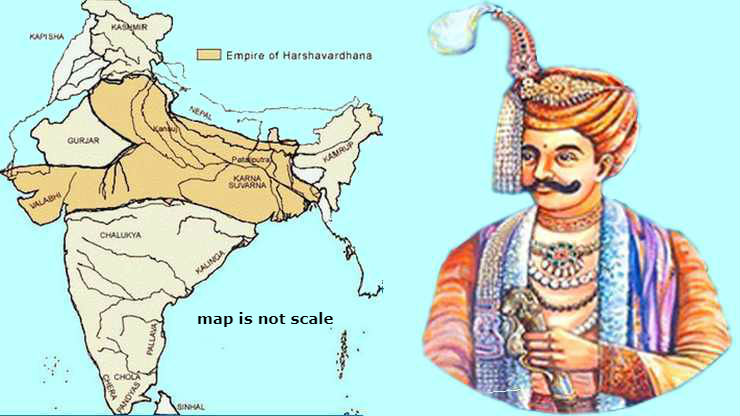Ancient Indian History – Period Of Harsha – Notes For – W.B.C.S. Examination.
- Rajyavardhana was killed by Gauda king Sasanka. Harshavardhana(younger brother of Rajyavardhana) was ascended the Pushyabhuti throne in A.D. 606 at the age of sixteen. He was also known as ‘Siladitya.’ He ruled for forty-one years.
- After Grahavarman’s death, the Councilors of Maukhari state offered the throne to Harsha.Continue Reading Ancient Indian History – Period Of Harsha – Notes For – W.B.C.S. Examination.
Sources of Harsha’s History
- History of the Harsha period is well documented by Banabhatta. He was a poet and he had written ‘Harshacharita.’ It is a detailed account of the events of the reign of Harsha.
- HiuenTsang (Chinese pilgrim) also had written in great detail about Harsha and India (of Harsha’s time).
- Harsha proceeded towards the east against Sasanka with a view to avenge the death of his brother, Rajyavardhana and brother-in-law, Grahavarman.
- Harsha did not get success in his first expedition against Gauda. But after the death of Sasanka, in his second expedition, he conquered Magadha and Sasanka’s empire.
- Gauda kingdom was divided between Harsha and Bhaskaravarman.
- Bhaskaravarman was the king of Kamarupa. He was an ally of Harsha against Gauda Kingdom.
- Harsh was successful in his military enterprise, and conquered a large part of the northern India.
- Harsha also launched a campaign to extend his empire beyond the Narmada, but he failed to do so.
- Aihole inscription mentions that Harsha was defeated by Pulakesin-II (Pulakesin-II was a Chalukya king of Badami).
- Hiuen-Tsang also mentioned that Harsha could not defeat the Chalukya king.
- Harsha’s empire was extended from the Punjab to northern Orissa and from Himalayas to the banks of Narmada.
- Harsh made military coilation with Dhruvabhatta II, the Maitraka king of Valabhi and Bhaskaravarman, the king of kings, Kamarupa.
- Harsha earned an undying reputation in the history of India for his peaceful activities as described by Hiuen – Tsang and by his biographer Banabhatta.
- Harsha, as a great emperor, was a patron of learning. He was himself a talented author. He wrote three Sanskrit plays, namely Nagananda, Ratnavali, and Priyadarsika.
- Banabhatta had written Harshacharita and Kadambari. He was a lerned poet.
- Harsha was an efficient administrator. He personally looked into the affairs of the state, and constantly travelled over different parts of his empire to see things with his own eyes.
- He was also a tolerant king. He was a Saiva by faith; however, he had given equal respect to other religious sects as well.
- Hiuen Tsang describes him as a liberal Buddhist who also honoured gods of others sects.
- Harsh’s charitable acts benefitted all the communities, sects, and religions.
- Harsha built rest houses, hospitals, and endowed numerous Brahmanical, Buddhist, and Jain establishments.
- The two most celebrated events of Harsha’s reign were the assemblies at Kanauj and at Prayaga.
- The Kanauj assembly was held in honor of Hiuen-Tsang for whom he had great affection and regard.
- Kanauj assembly was attended by 24,000 Buddhist monks, and about 3,000 Jains and Brahmans.
- After the ceremony at Kanuaj, Harsha along with Hiuen-Tsang went to Prayaga (Allahabad), at the confluence of the rivers Ganga, Yamuna, and Saraswati. Here he used to celebrate religious festivals at the end of every five years.
- Harsha performed the ceremony of ‘dana’ (donation), which lasted for about three months. During these three months, he donated all his accumulated wealth of five years. He even gave his clothes and jewelry and once begged from his sister an ordinary garment to put on.
- Harsha attended six such assemblies at Prayaga in his life time and donated all he had.
- In A.D. 641, Harsha sent an embassy with Hiuen-Tsang to the Chinese emperor and received the Chinese embassy in return.
- Harsha did not have any heir to his throne. Therefore, after his death in A.D. 647, his empire was grabbed by his minister.
Our own publications are available at our webstore (click here).
For Guidance of WBCS (Exe.) Etc. Preliminary , Main Exam and Interview, Study Mat, Mock Test, Guided by WBCS Gr A Officers , Online and Classroom, Call 9674493673, or mail us at – mailus@wbcsmadeeasy.in
Visit our you tube channel WBCSMadeEasy™ You tube Channel
Please subscribe here to get all future updates on this post/page/category/website



 Toll Free 1800 572 9282
Toll Free 1800 572 9282  mailus@wbcsmadeeasy.in
mailus@wbcsmadeeasy.in


















































































































